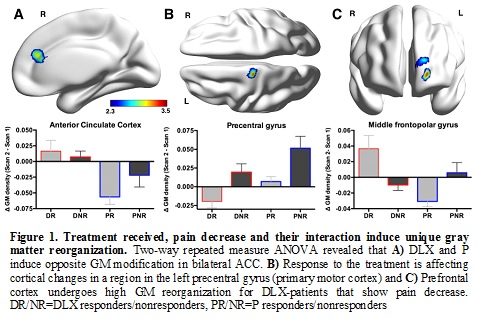Session Information
Session Type: Abstract Submissions (ACR)
Background/Purpose: Structural brain properties of patients coping with chronic painful conditions are becoming better understood but knowledge on how pain treatment affects these properties is still sparse. Assessment of cortical modifications during chronic pain evolution now permits identifying regions critically involved in painful pathologies. In this study, we evaluate structural brain reorganization of knee osteoarthritic (OA) patients after four months treatment with duloxetine (DLX) or placebo (P).
Methods: OA patients (n=40) meeting standard inclusion/exclusion criteria with pain ≥ 5 on 11 point NRS scale were randomized to DLX (60 mg) or placebo. Pain measurements were made at week 0, 2, 3, 6 and 16 and anatomic MRI scans done at baseline and at end of treatment (week 16). The total gray matter volume of the brain was obtained using SIENAX tool from FSL and cortical gray matter density (GMD) changes were evaluated using a voxel based morphometry approach (FSL-VBM). To evaluate structural brain properties, longitudinal contrast was made by using a two-way repeated measure ANOVA design.
Results: Patients were categorized as responders (≥ 20% pain decrease from baseline) and nonresponders in both DLX and placebo groups. The total gray matter volume showed an interaction of time*treatment*response (F=16.69, p < 0.001). Following treatment, DLX responders had a borderline significant volume increase (p=0.07); in contrast, placebo responders had a significant volume decrease (p < 0.05). Whole-brain voxel-wise VBM contrast (before – after treatment) revealed that DLX-treated patients underwent modification in GMD in the left precentral gyrus, left middle frontal gyrus and bilateral ACC (figure 1A). Interestingly, when patients positively responded to their treatment, independent of compound received, difference in GMD was observed only in the left precentral gyrus (figure 1B). In addition, regions in the left middle frontopolar (figure 1C) and inferior temporal gyri showed GMD changes when DLX induced pain relief. We thus show that some cortical regions presenting GMD reorganization were shared among all 4 groups studied, suggesting that a proportion of gray matter structural modification may be naturally occurring in time while other regional changes are directly related to treatment received.
Conclusion: Understanding how pharmacological treatment affects structural brain properties is important to assess drug efficacy and its potential deleterious effects. We herein show that pharmacological treatment of OA pain is affecting cortical reorganization in a way that is dependent on treatment, response and the interaction of both.
Disclosure:
P. Tetreault,
None;
M. Baliki,
None;
E. Vachon-Presseau,
None;
R. E. Yeasted,
None;
T. J. Schnitzer,
None;
A. V. Apkarian,
None.
« Back to 2014 ACR/ARHP Annual Meeting
ACR Meeting Abstracts - https://acrabstracts.org/abstract/cortical-reorganization-after-duloxetine-treatment-related-pain-decrease-in-knee-osteoarthritis/

